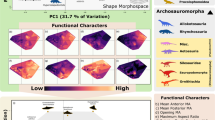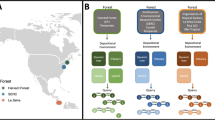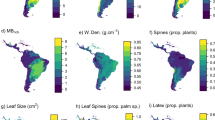Abstract
Dense branching and spines are common features of plant species in ecosystems with high mammalian herbivory pressure. While dense branching and spines can inhibit herbivory independently, when combined, they form a powerful defensive cage architecture. However, how cage architecture evolved under mammalian pressure has remained unexplored. Here we show how dense branching and spines emerged during the age of mammalian radiation in the Combretaceae family and diversified in herbivore-driven ecosystems in the tropics. Phylogenetic comparative methods revealed that modern plant architectural strategies defending against large mammals evolved via a stepwise process. First, dense branching emerged under intermediate herbivory pressure, followed by the acquisition of spines that supported higher speciation rates under high herbivory pressure. Our study highlights the adaptive value of dense branching as part of a herbivore defence strategy and identifies large mammal herbivory as a major selective force shaping the whole plant architecture of woody plants.
This is a preview of subscription content, access via your institution
Access options
Access Nature and 54 other Nature Portfolio journals
Get Nature+, our best-value online-access subscription
$29.99 / 30 days
cancel any time
Subscribe to this journal
Receive 12 digital issues and online access to articles
$119.00 per year
only $9.92 per issue
Buy this article
- Purchase on Springer Link
- Instant access to full article PDF
Prices may be subject to local taxes which are calculated during checkout







Similar content being viewed by others
Data availability
The descriptions data (cagey index and spines), the herbivory richness data and outputs for all analyses that support the findings of this study have been deposited in figshare (https://doi.org/10.6084/m9.figshare.24454609).
The additional datasets used in this study are GBIF datasets (GBIF.org, 27 October 2022, GBIF Occurrence Download: https://doi.org/10.15468/dl.7p2kpa) and data from the IUCN Red List Database (The IUCN Red List of Threatened Species v.2022-2; https://www.iucnredlist.org).
Code availability
The R code used for all analyses of this study have been deposited in figshare (https://doi.org/10.6084/m9.figshare.24454609).
Change history
20 March 2024
A Correction to this paper has been published: https://doi.org/10.1038/s41477-024-01675-2
References
Lavorel, S., McIntyre, S., Landsberg, J. & Forbes, T. D. A. Plant functional classifications: from general groups to specific groups based on response to disturbance. Trends Ecol. Evol. 12, 474–478 (1997).
Wigley, B. J. et al. A handbook for the standardised sampling of plant functional traits in disturbance-prone ecosystems, with a focus on open ecosystems. Aust. J. Bot. 68, 473–531 (2020).
Warming, E. & Vahl, M. Oecology of Plants: An Introduction to the Study of Plant-Communities (Clarendon Press, 1909).
Raunkiaer, C. The Life Forms of Plants and Statistical Plant Geography Being The Collected Papers of C. Raunkiaer (Clarendon Press, 1934).
Klimešová, J. & Herben, T. The hidden half of the fine root differentiation in herbs: nonacquisitive belowground organs determine fine‐root traits. Oikos https://doi.org/10.1111/oik.08794 (2023).
Jones, C. S. & Lord, E. M. The development of split axes in Ambrosia dumosa (Gray) Payne (Asteraceae). Bot. Gaz. 143, 446–453 (1982).
Eggli, U. & Nyffeler, R. Living under temporarily arid conditions – succulence as an adaptive strategy. Bradleya 2009, 13–36 (2009).
Arakaki, M. et al. Contemporaneous and recent radiations of the world’s major succulent plant lineages. Proc. Natl Acad. Sci. USA 108, 8379–8384 (2011).
Hoffmann, W. A. et al. Ecological thresholds at the savanna–forest boundary: how plant traits, resources and fire govern the distribution of tropical biomes. Ecol. Lett. 15, 759–768 (2012).
Williams, R. J., Cook, G. D., Gill, A. M. & Moore, P. H. R. Fire regime, fire intensity and tree survival in a tropical savanna in northern Australia. Aust. J. Ecol. 24, 50–59 (1999).
Lehmann, C. E. et al. Savanna vegetation-fire-climate relationships differ among continents. Science 343, 548–552 (2014).
Anest, A. et al. Evolving the structure: climatic and developmental constraints on the evolution of plant architecture. A case study in Euphorbia. New Phytol. 231, 1278–1295 (2021).
Jones, C. S. The effect of axis splitting on xylem pressure potentials and water movement in the desert shrub Ambrosia dumosa (Gray) Payne (Asteraceae). Bot. Gaz. 145, 125–131 (1984).
Pausas, J. G. et al. Towards understanding resprouting at the global scale. New Phytol. 209, 945–954 (2016).
Pausas, J. G. & Keeley, J. E. Epicormic resprouting in fire-prone ecosystems. Trends Plant Sci. 22, 1008–1015 (2017).
Simon, M. F. et al. Recent assembly of the Cerrado, a neotropical plant diversity hotspot, by in situ evolution of adaptations to fire. Proc. Natl Acad. Sci. USA 106, 20359–20364 (2009).
Hoffman, C. et al. Numerical simulation of crown fire hazard immediately after bark beetle-caused mortality in lodgepole pine forests. For. Sci. 58, 178–188 (2012).
Bouchenak-Khelladi, Y., February, E. C., Verboom, G. A. & Boucher, F. C. C4 grass functional traits are correlated with biotic and abiotic gradients in an African savanna. Plant Ecol. 221, 241–254 (2020).
Donoghue, M. J. & Sanderson, M. J. Confluence, synnovation, and depauperons in plant diversification. New Phytol. 207, 260–274 (2015).
Chomicki, G. Bringing Raunkiær with plant architecture: unveiling the climatic drivers of architectural evolution in Euphorbia. New Phytol. 231, 1278–1295 (2021).
Wigley, B. J., Coetsee, C., Fritz, H. & Bond, W. J. Herbivores shape woody plant communities in the Kruger National Park: lessons from three long-term exclosures. Koedoe 56, 1–12 (2014).
Charles-Dominique, T. et al. Spiny plants, mammal browsers, and the origin of African savannas. Proc. Natl Acad. Sci. USA 113, E5572–E5579 (2016).
Bucher, E. H. Herbivory in arid and semi-arid regions of Argentina. Rev. Chil. Hist. Nat. 60, 265–273 (1987).
Burns, C. E., Collins, S. L. & Smith, M. D. Plant community response to loss of large herbivores: comparing consequences in a South African and a North American grassland. Biodivers. Conserv. 18, 2327–2342 (2009).
Dantas, V. L. & Pausas, J. G. Megafauna biogeography explains plant functional trait variability in the tropics. Glob. Ecol. Biogeogr. 29, 1288–1298 (2020).
Bell, D. T. in Plant-Animal Interactions in Mediterranean-Type Ecosystems (eds Arianoutsou, M. & Groves, R. H.) 63–70 (Springer, 1994).
Hanley, M. E. Seedling herbivory, community composition and plant life history traits. Perspect. Plant Ecol. Evol. Syst. 1, 191–205 (1998).
Ash, A. J. & McIvor, J. G. How season of grazing and herbivore selectivity influence monsoon tall‐grass communities of northern Australia. J. Veg. Sci. 9, 123–132 (1998).
Hempson, G. P., Archibald, S. & Bond, W. J. A continent-wide assessment of the form and intensity of large mammal herbivory in Africa. Science 350, 1056–1061 (2015).
Tomlinson, K. W. et al. Defence against vertebrate herbivores trades off into architectural and low nutrient strategies amongst savanna Fabaceae species. Oikos 125, 126–136 (2016).
Bond, W. J. Large parts of the world are brown or black: a different view on the ‘Green World’ hypothesis. J. Veg. Sci. 16, 261–266 (2005).
Campagnolo, M. L., Libonati, R., Rodrigues, J. A. & Pereira, J. M. C. A comprehensive characterization of MODIS daily burned area mapping accuracy across fire sizes in tropical savannas. Remote Sens. Environ. 252, 112115 (2021).
Pausas, J. G. Pyrogeography across the western Palaearctic: a diversity of fire regimes. Glob. Ecol. Biogeogr. 31, 1923–1932 (2022).
Olff, H., Ritchie, M. E. & Prins, H. H. Global environmental controls of diversity in large herbivores. Nature 415, 901–904 (2002).
Berzaghi, F., Bretagnolle, F., Durand-Bessart, C. & Blake, S. Megaherbivores modify forest structure and increase carbon stocks through multiple pathways. Proc. Natl Acad. Sci. USA 120, e2201832120 (2023).
Bush, E. R. et al. Long-term collapse in fruit availability threatens Central African forest megafauna. Science 370, 1219–1222 (2020).
Archibald, S. & Bond, W. J. Growing tall vs growing wide: tree architecture and allometry of Acacia karroo in forest, savanna, and arid environments. Oikos 102, 3–14 (2003).
Charles‐Dominique, T., Barczi, J. F., Le Roux, E. & Chamaillé‐Jammes, S. The architectural design of trees protects them against large herbivores. Funct. Ecol. 31, 1710–1717 (2017).
Churski, M. et al. Herbivore‐induced branching increases sapling survival in temperate forest canopy gaps. J. Ecol. 110, 1390–1402 (2022).
Staver, A. C., Abraham, J. O., Hempson, G. P., Karp, A. T. & Faith, J. T. The past, present, and future of herbivore impacts on savanna vegetation. J. Ecol. 109, 2804–2822 (2021).
Edelin, C. The monopodial architecture: the case of some trees from tropical Asia. Research Pamphlet 105 (Forest Research Institute Malaysia, 1990).
Barthélémy, D. & Caraglio, Y. Plant architecture: a dynamic, multilevel and comprehensive approach to plant form, structure and ontogeny. Ann. Bot. 99, 375–407 (2007).
Cooper, S. M., Owen-Smith, N. & Bryant, J. P. Foliage acceptability to browsing ruminants in relation to seasonal changes in the leaf chemistry of woody plants in a South African savanna. Oecologia 75, 336–342 (1988).
Armani, M., Charles-Dominique, T., Barton, K. E. & Tomlinson, K. W. Developmental constraints and resource environment shape early emergence and investment in spines in saplings. Ann. Bot. 124, 1133–1142 (2019).
Wang, X., Fan, H., Phoncharoen, W., Gélin, U. & Tomlinson, K. W. Leaf chemistry of architecturally defended plants responds more strongly to soil phosphorus variation than non‐architecturally defended ones. Physiol. Plant. 175, e13856 (2023).
Lefebvre, T., Charles-Dominique, T. & Tomlinson, K. W. Trunk spines of trees: a physical defence against bark removal and climbing by mammals? Ann. Bot. 129, 541–554 (2022).
Stace, C. A. & Alwan Al-Mayah, A. R. Combretaceae. Flora Neotrop. Monogr. 107, 1–369 (2010).
Maurin, O. et al. Drift in the tropics: phylogenetics and biogeographical patterns in Combretaceae. Glob. Ecol. Biogeogr. 32, 1790–1802 (2023).
Stace, C. A. The significance of the leaf epidermis in the taxonomy of the Combretaceae. V. The genus Combretum subgenus Cacoucia in Africa. Bot. J. Linn. Soc. 81, 185–203 (1980).
Stace, C. A. The significance of the leaf epidermis in the taxonomy of the Combretaceae: conclusions. Bot. J. Linn. Soc. 81, 327–339 (1980).
Stace, C. A. Proposal to conserve Terminalia nom. cons. (Combretaceae) against an additional name, Bucida. Taxon 51, 193 (2002).
Rabosky, D. L. & Goldberg, E. E. Model inadequacy and mistaken inferences of trait-dependent speciation. Syst. Biol. 64, 340–355 (2015).
Beaulieu, J. M. & O’Meara, B. C. Detecting hidden diversification shifts in models of trait-dependent speciation and extinction. Syst. Biol. 65, 583–601 (2016).
Bond, W. J. Open Ecosystems: Ecology and Evolution Beyond the Forest Edge (Oxford Univ. Press, 2019).
Ordoñez, J. C. et al. A global study of relationships between leaf traits, climate and soil measures of nutrient fertility. Glob. Ecol. Biogeogr. 18, 137–149 (2009).
Gowda, J. H. Spines of Acacia tortilis: what do they defend and how? Oikos 77, 279–284 (1996).
Armani, M. et al. Structural defence is coupled with the leaf economic spectrum across saplings of spiny species. Oikos 129, 740–752 (2020).
Zhang, X. et al. Rapid Eocene diversification of spiny plants in subtropical woodlands of central Tibet. Nat. Commun. 13, 3787 (2022).
Fortelius, M. et al. Late Miocene and Pliocene large land mammals and climatic changes in Eurasia. Palaeogeogr. Palaeoclimatol. Palaeoecol. 238, 219–227 (2006).
Bell, A. D. & Bryan, A. Plant Form: An Illustrated Guide to Flowering Plant Morphology (Timber Press, 2008).
Rowe, N. & Speck, T. Plant growth forms: an ecological and evolutionary perspective. New Phytol. 166, 61–72 (2005).
Lahaye, R., Civeyrel, L., Speck, T. & Rowe, N. P. Evolution of shrub‐like growth forms in the lianoid subfamily Secamonoideae (Apocynaceae s.l.) of Madagascar: phylogeny, biomechanics, and development. Am. J. Bot. 92, 1381–1396 (2005).
Rule, S. et al. The aftermath of megafaunal extinction: ecosystem transformation in Pleistocene Australia. Science 335, 1483–1486 (2012).
Ripple, W. J. et al. Collapse of the world’s largest herbivores. Sci. Adv. 1, e1400103 (2015).
Faurby, S. & Svenning, J. C. Historic and prehistoric human‐driven extinctions have reshaped global mammal diversity patterns. Divers. Distrib. 21, 1155–1166 (2015).
Coverdale, T. C. Defence emergence during early ontogeny reveals important differences between spines, thorns and prickles. Ann. Bot. 124, iii–iv (2019).
Mertens, D. et al. Plant defence to sequential attack is adapted to prevalent herbivores. Nat. Plants 7, 1347–1353 (2021).
Neilson, E. H., Goodger, J. Q., Woodrow, I. E. & Møller, B. L. Plant chemical defense: at what cost? Trends Plant Sci. 18, 250–258 (2013).
Barton, K. E. Tougher and thornier: general patterns in the induction of physical defence traits. Funct. Ecol. 30, 181–187 (2016).
Harborne, J. B. in Plant Defenses Against Mammalian Herbivory (eds Palo, R. T. & Robbins, C. T.) Ch. 3 (CRC Press, 1991).
Wigley, B. J., Fritz, H. & Coetsee, C. Defence strategies in African savanna trees. Oecologia 187, 797–809 (2018).
Wigley, B. J., Coetsee, C., Mawoyo, K. A. & Fritz, H. No evidence for the simultaneous induction of structural and chemical defences in spiny southern African savanna trees. Austral Ecol. 47, 1415–1426 (2022).
Hunziker, P. et al. Herbivore feeding preference corroborates optimal defense theory for specialized metabolites within plants. Proc. Natl Acad. Sci. USA 118, e2111977118 (2021).
Gershenzon, J. & Ullah, C. Plants protect themselves from herbivores by optimizing the distribution of chemical defenses. Proc. Natl Acad. Sci. USA 119, e2120277119 (2022).
Gulewicz, P., Martinez-Villaluenga, C., Kasprowicz-Potocka, M. & Frias, J. Non-nutritive compounds in Fabaceae family seeds and the improvement of their nutritional quality by traditional processing – a review. Pol. J. Food Nutr. Sci. 64, 75–89 (2014).
Johnson, M. G. et al. A universal probe set for targeted sequencing of 353 nuclear genes from any flowering plant designed using k-medoids clustering. Syst. Biol. 68, 594–606 (2019).
Maurin, O. et al. A nuclear phylogenomic study of the angiosperm order Myrtales, exploring the potential and limitations of the universal Angiosperms353 probe set. Am. J. Bot. 108, 1087–1111 (2021).
GBIF Occurrence Download (GBIF.org, accessed 27 October 2022); https://doi.org/10.15468/dl.7p2kpa
Hallé, F., Oldeman, R. A. & Tomlinson, P. B. Tropical Trees and Forests: An Architectural Analysis (Springer, 2012).
R Core Team. R: A Language And Environment For Statistical Computing (R Foundation for Statistical Computing, 2022).
The IUCN Red List of Threatened Species Version 2022-2 (IUCN, accessed 14 March 2021); https://www.iucnredlist.org
Chamberlain, S. et al. rgbif: Interface to the Global Biodiversity Information Facility API. R package version 1.2.0 https://cran.r-project.org/package=rgbif (2019).
Zizka, A. et al. CoordinateCleaner: standardized cleaning of occurrence records from biological collection databases. Methods Ecol. Evol. 10, 744–751 (2019).
Kleyer, M. et al. Assessing species and community functional responses to environmental gradients: which multivariate methods? J. Veg. Sci. 23, 805–821 (2012).
Ho, L. S. T. et al. phylolm: Phylogenetic Linear Regression. R package version 2.6.2 http://cran.r-project.org/web/packages/phylolm/index.html (2016).
Harmon, L. et al. geiger: Analysis of Evolutionary Diversification. R package version 2.0.11 https://cran.r-project.org/package=geiger (2015).
Miller, R. G. Jr. in Simultaneous Statistical Inference 37–108 (Springer Series in Statistics, 1981).
Yandell, B. S. Practical Data Analysis for Designed Experiments Vol. 39 (CRC Press, 1997).
Revell, L. J. phytools: an R package for phylogenetic comparative biology (and other things). Methods Ecol. Evol. 2, 217–223 (2012).
Matzke, N. J. BioGeoBEARS: bioGeography with Bayesian (and likelihood) evolutionary analysis in R scripts. R package version 0.2 http://phylo.wikidot.com/biogeobears (2013).
Klaus, K. V. & Matzke, N. J. Statistical comparison of trait-dependent biogeographical models indicates that Podocarpaceae dispersal is influenced by both seed cone traits and geographical distance. Syst. Biol. 69, 61–75 (2020).
FitzJohn, R. G. Diversitree: comparative phylogenetic analyses of diversification in R. Methods Ecol. Evol. 3, 1084–1092 (2012).
Smith, S. A. & O’Meara, B. C. treePL: divergence time estimation using penalized likelihood for large phylogenies. Bioinformatics 28, 2689–2690 (2012).
Nakov, T., Beaulieu, J. M. & Alverson, A. J. Diatoms diversify and turn over faster in freshwater than marine environments. Evolution 73, 2497–2511 (2019).
Beaulieu, J., O’Meara, B., Caetano, D., Boyko, J. & Vasconcelos, T. hisse: Hidden State Speciation and Extinction. R package version 2.1.11 https://cran.r-project.org/package=hisse (2023).
Acknowledgements
A.A. was sponsored by the 2018 CAS-TWAS President’s Fellowship for International Doctoral Students (20180479). The work was supported by a Yunnan Province 1000 Talents grant to K.W.T. (E0YN021). Calculations were performed using HPC resources from DNUM CCUB (Centre de Calcul de l’Université de Bourgogne).
Author information
Authors and Affiliations
Contributions
A.A., T.C.-D. and K.W.T. designed the project. A.A. conducted data collection and processing. A.A. and Y.B.-K. performed the analyses. A.A., Y.B.-K., T.C.-D., Y.C., F.F., G.P.H., O.M. and K.W.T. wrote the manuscript.
Corresponding authors
Ethics declarations
Competing interests
The authors declare no competing interests.
Peer review
Peer review information
Nature Plants thanks Domingos Cardoso and Guillaume Chomicki for their contribution to the peer review of this work.
Additional information
Publisher’s note Springer Nature remains neutral with regard to jurisdictional claims in published maps and institutional affiliations.
Supplementary information
Supplementary Information
Supplementary Tables 1–21, Figs. 1–14, Notes 1 and 2, Scripts 1–3 and References.
Rights and permissions
Springer Nature or its licensor (e.g. a society or other partner) holds exclusive rights to this article under a publishing agreement with the author(s) or other rightsholder(s); author self-archiving of the accepted manuscript version of this article is solely governed by the terms of such publishing agreement and applicable law.
About this article
Cite this article
Anest, A., Bouchenak-Khelladi, Y., Charles-Dominique, T. et al. Blocking then stinging as a case of two-step evolution of defensive cage architectures in herbivore-driven ecosystems. Nat. Plants 10, 587–597 (2024). https://doi.org/10.1038/s41477-024-01649-4
Received:
Accepted:
Published:
Issue Date:
DOI: https://doi.org/10.1038/s41477-024-01649-4



